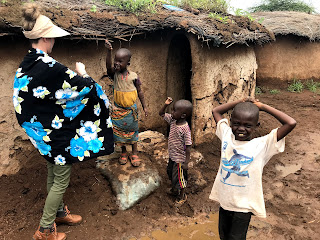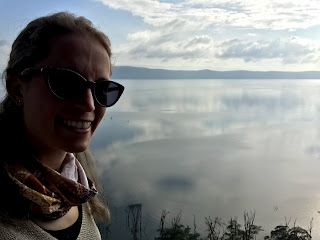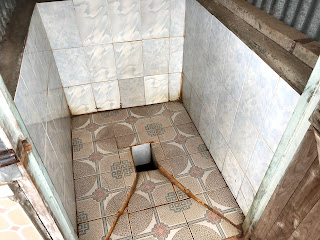Up and at 'em for our 630 game drive. David found out that the road we had taken yesterday was closed because of flooding (shocker!!) so we had to use an alternate road. In the light of the morning we enjoyed the elephant herds roaming and feeding, the zebras grazing and the topis twirling their tails about. We saw many different types of birds, but no lions.
On our way back to the camp we witnessed an elephant standoff. David explained that the two animals facing one another across the road were fighting for dominance within the herd. The larger elephant, with the bigger tusks, was the older one, and he was being challenged by the younger male with smaller tusks. The younger male kept using his trunk to throw dirt over his body and pull his foot back and forth in the dirt while waving his ears. The older elephant just stared, occasionally moving his ears. David explained that it could take hours, days or weeks for the final showdown. The females in the herd would accept whichever male was dominant and banish the other.
We returned to camp around 930, just in time for breakfast. Mark hit the showers once he finished eating, but I stayed for a hot tea and a chat with one of the chow tent workers, Lavender. Her hair was braided in an absolutely beautiful way culminating in a crown around the top of her head. She explained that it wasn't her real hair and that when she got this style done it took about two and a half hours and could be left in for three to four weeks. She marveled over my hair, exclaiming how beautiful it was when styled naturally. We laughed at the age old saying, "you always want what you can't have." Lavender is originally from Nairobi but was attending school for hotel management. She finished school and was called to work at Kibo Safari Camp shortly after graduating. She's been here almost a year and hopes to gain enough experience to open her own hotel one day. She prays that if she works hard and has faith in god she will succeed. Talking with her was lovely and I wish her all the best.
Mark and I then met a local Masai, Ramone, who took us to his village. It was a thirty minute walk from Kibo and it was in and out of swamp, thick mud and tall grasses with one constant: heat. We walked by a permanent school, and hospital, both built by volunteers from the US. These are the only two buildings in the village with power and running water. As we continued we finally came to the Masai camp, which included an outer fence made of bushes and trees, to protect from wild animals, followed by a circle of eight huts followed by an inner circle where livestock were kept.
The Masai first showed us how to make fire using a combination of zebra and elephant dung powder, wood and sticks. The process was really slow and caused the men to inhale tons of smoke but eventually the fire started. I couldn't imagine doing this each time I wanted to cook, drink water, or keep warm.
We then went inside a Masai hut. The huts are built first with strong special sticks from Mt. Kilimanjaro. These are gathered once per year. 10 men and 10 donkeys from the village make the two week trip. During the rainy season this wood is stored in the huts to ensure it stays dry. Once the women are ready to build a new hut (all Masai homes are built by women) they combine the wood from Mt. Kilimanjaro with wood from the acacia trees to make the base. They then cover the base in cow dung which acts like a cement and an insulator. The roof is made from nylon paper and sticks. The houses are subject to flooding and termite damage but the combination of wood keeps them strong and durable for up to twenty years. The homes are incredibly small. The one Mark and I entered had two rooms, one for the women and children and one for the men. A small bed is raised off of the floor using wooden beams and is covered with cow hide. In the center of the hut is a small fire that continuously smokes (this keeps the mosquitoes away) and also serves as a place to boil water and cook food. There are no toilets or showers. Because the homes are made of dung the amount of flies is unreal. You can tell that Mark and I are tourists (for many reasons!) specifically because each time a fly landed on us we would instinctively swat at it or flinch to make it fly away. The Masai on the other hand will be covered in swarms of them and still talking and working, seemingly not even phased by the hundreds of flies on their faces, arms and legs. It was really hard for me to talk with one of the young boys in the village (he was maybe three or four) because the flies kept landing on his lips. I wanted so badly to shoo them away for him.
We then watched a series of Masai dances (Mark and I can probably perform these in our sleep at this point), one of which was a prayer for our safe return home. Next we looked at the handmade items made by the women and men in the village. Women do beading and paint work while men do wood carving. The beaded bracelets are beautiful so I bought a few from the women.
We learned that the Masai have one leader, a man who is chosen by all to lead because of his good character. He distributes all of the money between the villagers. Those in the village who wear ear decorations were not able to attend school and are therefore uneducated. Many Masai have brandings on their cheeks because the medicine man says it will help with poor eyesight. This is performed on children when they're 8 or 9 years of age. The women are tasked with building the homes, cooking and washing while the men must farm, look after the animals and the children. Women must shave their heads (I think this is more for hygiene than anything else) and men who are unmarried warriors must grow their hair long.
One of my favorite takeaways were the shoes- they're made from motor bike tires because they're durable and won't lose traction in the mud. They're also very easy to clean. And they look super cool, obviously. I asked about getting a pair but the Masai wanted 50 euro for them. I'm sure I can find DIY Pinterest instructions for these, thanks though.
After leaving I had incredibly conflicting feelings about the village- was this a tourist stunt? Do they really live like this? Whether this particular village was legitimate I'll never know, however driving on the streets of Kenya and seeing villages like this in rural and remote areas makes me believe that there are people who live like this not because they're hoping for a few bucks from a tourist, but because this is their life. These are their means. This is their home.
After spending two and a half hours in the heat we were ready for some lunch. Spaghetti with tomato sauce (how african) with fruit salad. We relaxed for a bit and then headed out for our last game drive. We got to see more hippos (at a safe distance), this time playing with one another in the lake. We saw bastard birds and a bull who had been kicked out of his herd. We saw a jackal and of course giraffes, elephants, zebras, gazelles and buffalo. We watched the sun set over the savannah as we drove with the wind blowing our hair.


























































